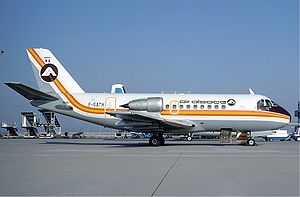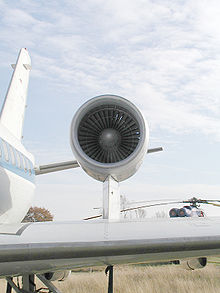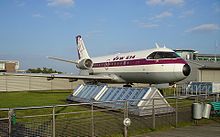VFW-Fokker 614 Video - Picture

|
|
VFW-Fokker 614
VFW 614

Picture - VFW 614 of Air Alsace at Basle Airport in 1977
Role: Regional airliner
Manufacturer: Fokker VFW
First flight: 14 July 1971
Introduced: August 1975
Primary users: Luftwaffe
Touraine Air Transport
Air Alsace
Cimber Air
The VFW-Fokker 614 (also VFW 614) was a twin-engined jetliner designed and built in West Germany. It was produced in small numbers by VFW-Fokker in the early- to mid-1970s, and originally intended as a DC-3 replacement. Its most distinctive feature was that its engines were mounted in pods on pylons above, rather than below, the wing.
Design and development
The VFW 614 is often described as being ahead of its time. It was a brave but in the end unsuccessful attempt to build and market a small capacity regional jet, a market sector that has developed only recently with the strong sales of aircraft such as the Canadair CRJs and Embraer ERJs.
The VFW 614 was originally proposed in 1961 by the Entwicklungsring Nord (ERNO) group, comprising Focke-Wulf, Hamburger Flugzeugbau (HFB) and Weser as the E.614, a 36-40 seat aircraft powered by two Lycoming PLF1B-2 turbofans. West German industry was subsequently reorganised and Vereinigte Flugtechnische Werke (VFW) was established at Bremen. Development of what was now the VFW 614 continued.
Although Lycoming abandoned the PLF1, development continued as using the Rolls-Royce/SNECMA M45H turbofan, which was developed specially for the VFW 614. In 1968, the project was given the go-ahead, with 80 percent of the backing coming from the West German Government. Full scale production was approved in 1970, by which time VFW had merged with Fokker (a somewhat unhappy arrangement which lasted for only ten years). Also risk sharing agreements had been concluded with SIAT in Germany, Fairey and SABCA in Belgium and Shorts in the UK. Final assembly of the aircraft would be done in Bremen.

Picture - overwing pylon mounted Rolls Royce powerplant
The first of three prototypes flew on July 14, 1971. The aircraft was revealed to be of unconventional configuration, with two quiet, smoke-free, but untested M45H turbofans mounted on pylons above the wings. This arrangement was used to avoid the structural weight penalties of rear mounted engines and the potential ingestion problems of engines mounted under the wings, and allowed a short and sturdy undercarriage, specially suited for operations from poorly prepared runways.
Development of the aircraft was protracted and orders slow to materialise, despite a strong marketing campaign. The orders situation was not helped by Rolls-Royce's bankruptcy in 1971 which threatened the supply of engines. Also, the first prototype was lost on 1 February 1972 due to elevator flutter, worsening the order situation. By February 1975 only 10 had been ordered. The first production VFW-614 flew in April 1975 and was delivered to Denmark's Cimber airlines 4 months later.
Operational history
Only three airlines and the Luftwaffe operated new VFW 614s. The aircraft was initially prone to engine problems, and suffered the fundamental problem that it was too expensive for the small regional airlines for which it was planned. Three aircraft were flown but never delivered, and four airframes were broken-up before completion. The program was officially cancelled in 1977, and the last unsold aircraft flew in July 1978. Most aircraft had been disposed of by 1981, with the manufacturer buying the aircraft and simultaneously ending support of the aircraft. Thereafter, only the Luftwaffe aircraft remained in service, being disposed of in 1999. The last airworthy VFW 614 was in use with DLR for the Advanced Technologies Testing Aircraft System (ATTAS)-Project. Freundeskreis VFW614 e.V. reported that the certificate of airworthiness for DLR's VFW-614 ATTAS Project was withdrawn on 12 Nov 2004 and is now replaced by an Airbus A320.
Operators

Picture - VFW 614 Cimber Air
Denmark
Cimber Air received two aircraft.
France
Air Alsace bought three aircraft.
Touraine Air Transport was main operator with eight aircraft.
West Germany
Luftwaffe received three aircraft.
Survivors
There is a VFW 614 on display in the Deutsches Museum in Munich, in the Aeronauticum in Nordholz, another on the visitor's terrace at Bremen Airport, another on display at the Technikmuseum Speyer and a fourth being used as a training aid for Lufthansa Resource Technical Training at Cotswold Airport, England.
Specifications (VFW 614)

Picture - VFW 614
Data from The Observer's Book of Aircraft, 1976.
General characteristics
Crew: Two
Capacity: 40-44 passengers in 4 abreast seating
Length: 20.60 m (67 ft 7 in)
Wingspan: 21.50 m (70 ft 6.5 in)
Height: 7.82 m (25 ft 8 in)
Wing area: 64.0 m² (689 ft²)
Empty weight: 12,179 kg (26,850 lb)
Max takeoff weight: 19,958 kg (44,000 lb)
Powerplant: 2x— Rolls-Royce/Snecma M45H Mk. 501 turbofan, 33.2kN (7,473 lbf) each
Performance
Maximum speed: 704 km/h (380 knots, 437 mph)
Cruise speed: 722 km/h (449 mph)
Range: 1,195 km (645 nm, 743 mi) with 40 passengers
Service ceiling: 7,620 m (25,000 ft)
Rate of climb: 945 m/min (3,100 ft/min)
Bibliography
Green, William. The Observer's Book of Aircraft. London. Frederick Warne & Co. Ltd., 1976. ISBN 0-7232-1553-7.
Jackson, Paul A. German Military Aviation 1956-1976. Hinckley, Leicestershire, UK: Midland Counties Publications, 1976. ISBN 0-904597-03-2.
Mellberg, Bill. "VFW 614:Ahead of its Time". Air International, February 1995, Vol 48 No 2. Stamford, UK:Key Publishing. ISSN 0306-5634. pp. 94-99.
VFW-Fokker 614 Pictures
More aircraft.
Source: WikiPedia